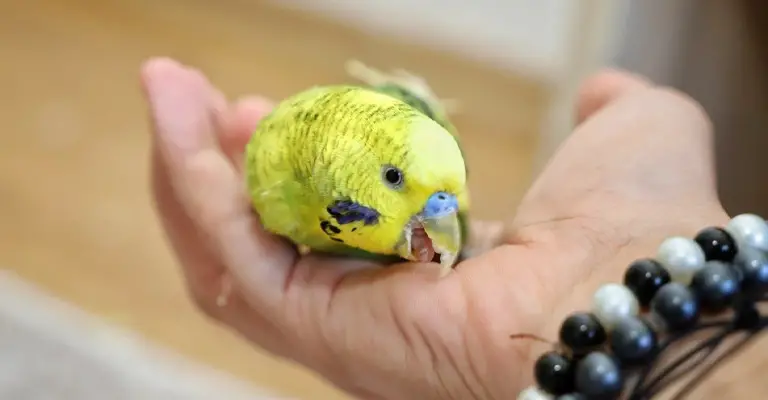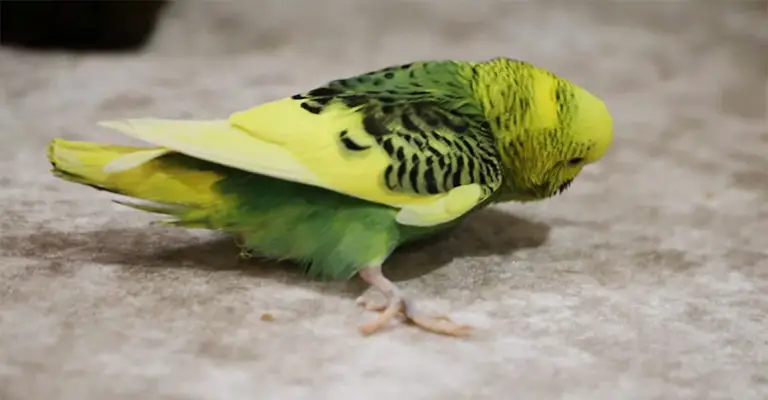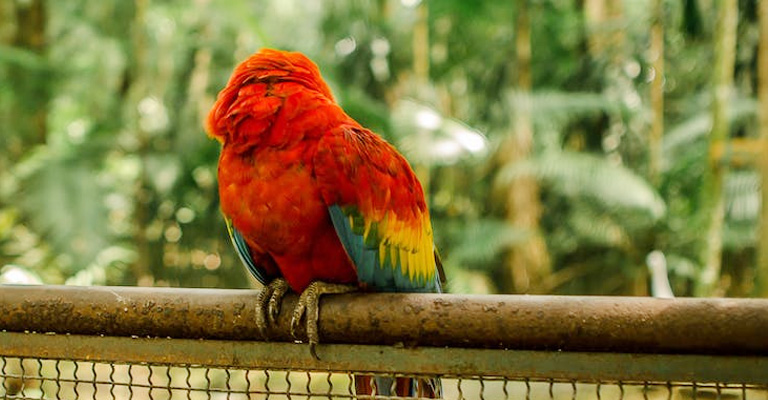Heat stroke is a severe condition that can affect birds of any species, especially if they are exposed to high temperatures and humidity without adequate shade, ventilation, or water.
Heat stroke can cause irreversible damage to the brain and other organs and can be fatal if not treated promptly.
This article will discuss heat stroke, how to recognize its symptoms, and how to treat and prevent it in pet birds.

What Is A Heat Stroke?
Heat stroke is a condition that occurs when the body’s temperature rises above its normal range and cannot cool down effectively.
Depending on the species, birds have a higher body temperature than humans, ranging from 38°C to 44°C. They also lack sweat glands, so they rely on other mechanisms to regulate their temperature, such as:
- Fluffing their feathers to trap air and create insulation
- Holding their wings away from their body to increase heat loss
- Panting or gular flapping (rapidly moving their throat) to evaporate water from their mouth and air sacs
- Seeking shade or water to cool down
However, more than these mechanisms may be needed if the environmental temperature and humidity are too high or if the bird is dehydrated, overweight, stressed, or ill.
In such cases, the bird’s body temperature may rise above 45°C, damaging the brain’s and other organs’ cells and tissues. This can lead to seizures, coma, and death.
What Are The Symptoms Of Heat Stroke In Birds?

Heat stroke is a life-threatening condition when a bird’s body temperature rises above its normal range and causes damage to its organs and tissues.
Heat stroke can have different symptoms depending on the severity of the condition and the individual bird. Here are some common signs to look out for:
Breathing Problems
One of the first signs of heat stroke is panting or gular flapping. This is when a bird breathes rapidly through its mouth or beak or moves its throat up and down to increase airflow. This indicates that the bird is trying to cool down its body by evaporating water from its mouth or skin.
Posture Changes
Another sign of heat stroke is holding the wings away from the body. This is when a bird spreads its wings to expose more surface area to the air and release heat. This also indicates that the bird is trying to cool down its body by increasing blood flow to its wings.
Behavior Changes

Heat stroke can also affect a bird’s behavior and mental state. A bird may become lazy or weak and lose interest in its surroundings or activities.
A bird may also become anxious or agitated and try to escape from its cage or environment. A bird may also lose balance or coordination, fall off its perch, or stumble around.
Neurological Problems
Heat stroke can also cause neurological problems in birds. A bird may experience convulsions, seizures, involuntary muscle spasms, or contractions. A bird may also lose consciousness or die from severe and untreated heat stroke.
How To Treat Heat Stroke In Birds?

If you suspect that your bird has heat stroke, you should act quickly and follow these steps:
Move The Bird To A Cooler Location
The first step in treating heat stroke is to move the bird to a cooler and quieter location, away from direct sunlight and heat sources.
You can also mist the bird with water until its skin is wet or place it in a shallow container of cool water. This will help lower its body temperature and prevent further damage.
Provide Fresh Water And Food
You should also provide fresh water for the bird to drink, preferably with some electrolytes added (such as Gatorade) to replenish its fluids and minerals.
You can also offer some fruits or vegetables with high water content, such as grapes, melon, or cucumber. Do not force the bird to drink or eat if it is unwilling or unable to do so.
Avoid Common Mistakes
Do not wrap the bird in a towel or blanket, which may trap heat and worsen the condition. Do not apply ice or cold packs directly to the bird’s skin, which may cause frostbite or shock.
Contact Your Veterinarian
Monitor the bird closely for any changes in its condition, and contact your veterinarian as soon as possible for further advice and treatment.
Your veterinarian may perform some tests to assess the extent of the damage and provide supportive care such as oxygen therapy, fluid therapy, anti-inflammatory drugs, or antibiotics.
How To Prevent Heat Stroke In Birds?

Heat stroke is a life-threatening condition when a bird’s body temperature rises above its normal range and causes damage to its organs and tissues. Heat stroke can be prevented by avoiding exposing your bird to excessively high temperatures and humidity.
Here are some tips to help you keep your bird cool and comfortable:
Provide Shade And Ventilation
Provide adequate shade and ventilation for your bird’s cage or enclosure. You can use curtains, blinds, fans, or air conditioners to block or reduce the heat and sunlight. You can also move your bird’s cage to a cooler area of your house or outside if the weather permits.
Avoid Heat Sources
Avoid placing your bird’s cage near windows, heaters, ovens, or other heat sources. These can create hot spots or increase the temperature in your bird’s environment. You can also cover your bird’s cage with a light-colored cloth or sheet to reflect the heat.
Provide Fresh Water And Food
Provide fresh water for your bird at all times, and change it frequently. Water helps your bird regulate its body temperature and prevent dehydration.
Add ice cubes or frozen fruits to the water to keep it cool. Avoid feeding your bird too much protein or fat, which can increase its metabolic rate and heat production.
Instead, offer fresh fruits and vegetables with high water content, such as grapes, melon, or cucumber.
Keep Your Bird Healthy
Keep your bird at optimal weight and health, and consult your veterinarian regularly for check-ups and vaccinations. A healthy bird is more resilient and able to cope with heat stress. A sick or overweight bird is more prone to heat stroke and other complications.
Avoid Stress
Avoid stressing your bird with loud noises, sudden changes, or unfamiliar situations. Stress can increase your bird’s heart rate, blood pressure, and body temperature.
It can also lower your bird’s immune system and make it more susceptible to infections. You can help your bird relax by providing toys, perches, social interaction, and a calm environment.
FAQ
Heat stress is a mild form of heat-related illness when the body’s temperature rises slightly above its expected range but can still cool down effectively. Heat stress may cause discomfort or fatigue but does not cause serious damage. Heat stroke is a severe form of heat-related illness when the body’s temperature rises significantly above its expected range and cannot cool down effectively.
Yes, heat stroke can cause permanent damage to your bird’s brain and other organs, depending on the duration and severity of the condition
Conclusion
Heat stroke is a severe condition that can affect birds of any species, especially if they are exposed to high temperatures and humidity without adequate shade, ventilation, or water. Heat stroke can cause irreversible damage to the brain and other organs and can be fatal if not treated promptly.
To prevent heat stroke, always avoid exposing your bird to high temperatures and humidity for prolonged periods and provide fresh water, shade, and ventilation.
If you suspect your bird has heat stroke, move it to a more incredible location, mist it with water, provide electrolytes, and contact your veterinarian as soon as possible.